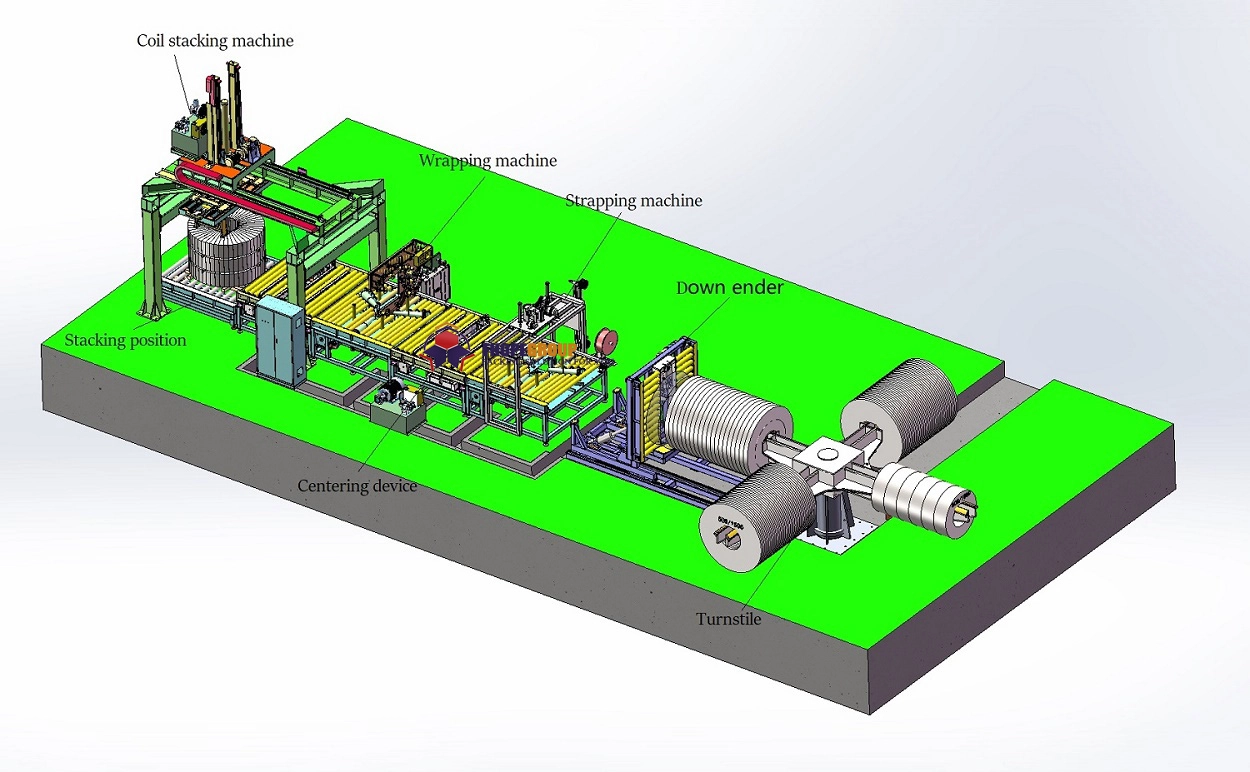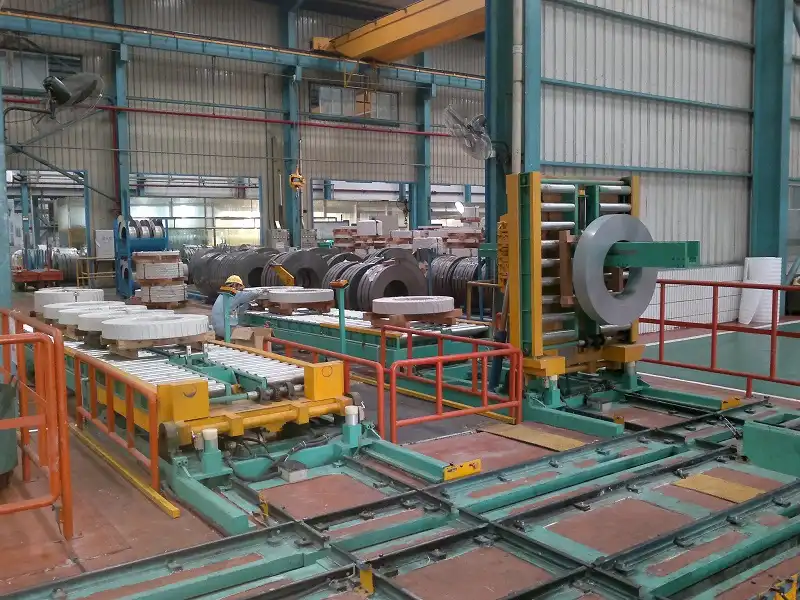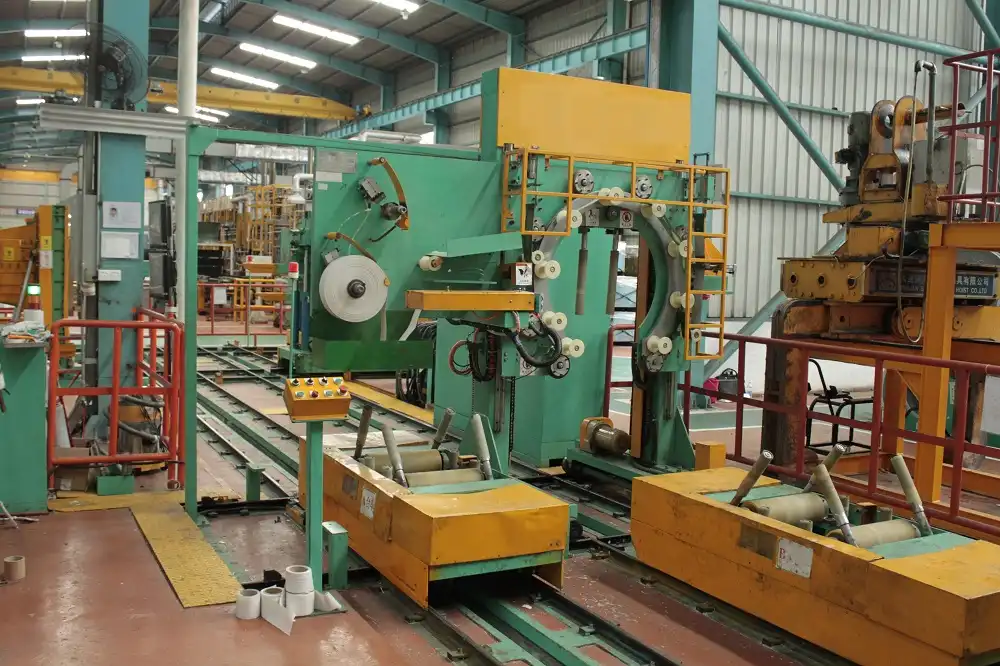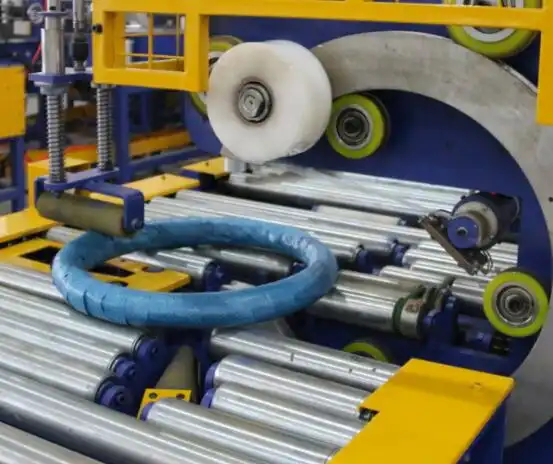Your coil packing line is the final gatekeeper before your products reach the customer. When it runs smoothly, so does your business. But when it stops, everything grinds to a halt. An unexpected breakdown means idle workers, stalled shipments, and mounting pressure on you to fix it, fast. You watch the clock, knowing every minute of downtime is money lost. It feels like you are constantly putting out fires instead of preventing them. What if you could change that? What if you could move from a reactive state of crisis management to a proactive state of control, ensuring your line runs reliably day in and day out?
To maximize uptime, you must shift from a reactive to a proactive maintenance strategy for your coil packing line. This means creating a detailed schedule for regular inspections, cleaning, and lubrication. It involves training your team to spot early warning signs and keeping a stock of critical spare parts. By addressing small issues before they become major failures, you ensure consistent performance and prevent costly, unexpected shutdowns.

This might sound straightforward, but putting it into practice in a busy factory environment is the real challenge. It requires more than just a checklist; it requires a change in mindset. Let's break down how you can build a robust maintenance strategy that truly protects your production schedule and your bottom line. I've built factories and helped hundreds of clients grow their businesses, and I want to share what I've learned about keeping these critical machines running.
What's the True Cost of Reactive Maintenance on Your Packing Line?
You see a machine stop, and your first thought is the immediate cost: how much for the part, how much for the technician's time? It's a natural reaction. But the machine breaking down is just the tip of the iceberg. The real damage is happening below the surface, in ways that don't show up on a simple repair invoice. The pressure to get the line running again is immense because you know that a silent clock is ticking, counting costs that are much larger than the repair itself.
The true cost of reactive maintenance is a cascade of hidden expenses that go far beyond the direct repair bill. It includes the value of lost production, overtime pay for your team to catch up, potential damage to your product during the failure, and the long-term erosion of customer trust due to delivery delays. These indirect costs can often be 10 to 20 times greater than the initial part and labor costs.

In my years of working with factory managers like you, I've seen this scenario play out time and time again. The focus is always on the visible problem, but the invisible consequences are what truly hurt a business. To make the best decisions for your factory, you need to see the full picture.
Diving Deeper: Uncovering the Hidden Financial Drains
Let's separate these costs into two categories: the obvious ones and the ones that quietly drain your profitability. A manager who only looks at the first group is always going to be surprised by their end-of-month numbers. A great manager, like you want to be, understands and controls both.
Direct Costs vs. Hidden Costs
The difference is stark when you lay it all out. Reactive maintenance seems cheaper on paper until a failure occurs.
| Cost Type | Reactive Maintenance ("Firefighting") | Proactive Maintenance ("Fire Prevention") |
|---|---|---|
| Direct Costs | - Emergency repair labor (often at overtime rates) - High cost of expedited parts shipping - Replacement parts |
- Scheduled maintenance labor - Planned parts inventory - Consumables (lubricants, cleaners) |
| Hidden Costs | - Lost Production: Every minute the line is down is product you aren't shipping. - Idle Workforce: Your operators are paid to stand and wait. - Product Damage: A sudden stop or malfunction can damage the coil or wire, leading to scrap. - Safety Risks: Rushing to fix a problem increases the chance of accidents and injuries. - Reputation Damage: Late shipments damage your relationship with customers. - Management Stress: Your time is spent on crises, not on growth. |
- Minimal, planned downtime during off-peak hours. |
I remember a client in the steel industry. His wrapper's main drive motor failed unexpectedly. The direct cost for a new motor and an emergency technician was about $3,500. He thought that was the end of it. But the line was down for 18 hours. He calculated the lost production value at over $40,000. He then had to pay his team for a full weekend of overtime to catch up, which cost another $8,000. So, a $3,500 "problem" actually cost his business over $51,500. This doesn't even account for the strained relationship with the client whose order was delayed. That experience was a powerful lesson. He realized that spending a few hundred dollars on regular motor inspections and predictive analysis could have saved him tens of thousands. This is the reality of reactive maintenance. It's a gamble where the house always wins.
How Can a Proactive Maintenance Schedule Prevent Unexpected Downtime?
You know your production targets are aggressive. The pressure is always on to keep the line moving. It feels like there's never a "good" time to stop for maintenance. So, you push it off. "We'll do it next week." But next week brings its own pressures. Then, the inevitable happens. The machine breaks down during your busiest shift, and you're forced into a shutdown that is far longer and more disruptive than any planned maintenance would have been.
A proactive maintenance schedule prevents unexpected downtime by turning maintenance into a controlled, planned activity instead of a chaotic emergency. By systematically checking, cleaning, and servicing components at regular, scheduled intervals—like during shift changes or planned lulls—you identify and fix potential problems before they can cause a catastrophic failure during peak production.

The goal isn't to add more work to your plate. It's to trade unpredictable, high-stress downtime for predictable, low-impact service windows. This simple shift in approach gives you control over your production environment. It’s the difference between steering the ship and being tossed around by the waves.
Diving Deeper: From Checklist to Culture
Creating a schedule is easy. Making it a part of your factory's daily life is the hard part. It requires clear instructions, assigned responsibility, and a commitment from everyone on the team.
Building Your Foundational Maintenance Schedule
A good schedule is simple, clear, and actionable. It should not require an engineering degree to understand. You can build it out based on frequency. Here is a basic template you can adapt for your specific machine. The key is to start somewhere.
| Task | Frequency | Responsible | Check |
|---|---|---|---|
| Daily (Before Shift Start) | |||
| Visually inspect for loose bolts or debris | Daily | Operator | [ ] |
| Check for any unusual noises during startup | Daily | Operator | [ ] |
| Confirm all safety guards are in place | Daily | Operator | [ ] |
| Weekly | |||
| Clean sensors and reflectors | Weekly | Maintenance Tech | [ ] |
| Check conveyor belt tension and tracking | Weekly | Maintenance Tech | [ ] |
| Lubricate chain drives and moving joints | Weekly | Maintenance Tech | [ ] |
| Inspect wrapping ring for any film residue | Weekly | Maintenance Tech | [ ] |
| Monthly | |||
| Test Emergency Stop button functionality | Monthly | Maintenance Lead | [ ] |
| Inspect electrical cabinet for dust/loose wires | Monthly | Maintenance Lead | [ ] |
| Check friction wheel pressure and wear | Monthly | Maintenance Lead | [ ] |
| Review error logs from the PLC/HMI | Monthly | Maintenance Lead | [ ] |
Integrating Maintenance into Your Workflow
Once you have the "what" and "when," you need to figure out the "how." The worst way to do maintenance is to interrupt a full-speed production run. Instead, you need to be smart about timing. Look for the natural pauses in your day. Schedule the 10-minute daily checks during the shift handover. Use the 30-minute lunch break to perform weekly lubrication tasks. Plan the more involved monthly checks for a scheduled changeover or a weekend. By pairing maintenance activities with existing downtime, you make it part of the routine. It stops being an interruption and starts being a tool that enables more consistent production. In my own factory, we made the pre-shift check a mandatory part of the operator's startup procedure. It added five minutes to the start of the day but saved us hours of unplanned downtime each month. It’s a small investment of time for a massive return in reliability.
What Key Components of a Coil Packing Line Need Regular Attention?
A coil packing line is a tough piece of machinery, but it's not invincible. It’s a system of many parts working together under high stress. When you look at the whole machine, trying to figure out what to check can feel overwhelming. You can't inspect every single nut and bolt every day. If you try to focus on everything, you'll end up focusing on nothing, and you'll still miss the critical failure points. The secret is to know which components do the most work and bear the most strain.
The key components of a coil packing line that need the most regular attention are the ones in constant motion or under high stress: the wrapping ring and its drive system, the conveyor belts and rollers, the film cutting and clamping unit, and the electrical sensors that control the entire process. These four areas are responsible for over 80% of potential failures and must be the focus of any effective maintenance plan.

Think of it like maintaining a car. You don't check the wheel nuts as often as you check the oil level or tire pressure. Why? Because the oil and tires are under constant stress and are critical for operation. It's the same principle with your packing line. By focusing your efforts on these vital systems, you can maximize the impact of your maintenance time.
Diving Deeper: A Focused Look at Critical Systems
Let's break down these key areas. For each one, you need to understand its job, what commonly goes wrong, and what you can do to prevent it.
The Wrapping Ring and Drive System
This is the heart of your machine. The ring spins at high speed, wrapping the coil. It's driven by either a belt or a series of friction wheels. This constant motion creates wear.
- What to look for: Listen for unusual noises like grinding or squealing, which can signal bearing failure. Look for vibrations in the ring, which could mean the drive wheels are worn unevenly. Check the drive belt for cracks and proper tension. If it's too loose, it will slip. If it's too tight, it will strain the motor and bearings.
- Proactive Care: Keep the friction wheels clean from dust and grease. A dirty wheel can't grip properly, leading to inconsistent wrapping. On a weekly basis, check that the wheels are making firm, even contact with the ring. Lubricate bearings according to the manufacturer's schedule. A little grease is much cheaper than a new bearing and the downtime to install it.
The Conveyor System
The conveyors move heavy coils into and out of the wrapping station. A failure here can damage the product or create a serious safety hazard. This is often where damage to the edges of steel coils happens.
- What to look for: Watch the conveyor belts to see if they are tracking straight. A belt that wanders to one side can get frayed and will eventually fail. Listen for squeaking rollers, which indicates a bearing is failing. Check the conveyor chains for proper tension. A loose chain can jump off its sprocket.
- Proactive Care: Daily, operators should ensure the conveyor path is clear of debris. Weekly, a technician should check belt and chain tension and lubricate the chain. If a roller is seized or noisy, replace it immediately. A single bad roller can destroy a conveyor belt over time.
The Film Cutting and Clamping Unit
This system automatically cuts the stretch film and clamps it to begin the next cycle. It’s a precise mechanism, and if it fails, your line stops.
- What to look for: Inconsistent cuts or tails of film left on the package are signs of a dull or misaligned blade. If the clamp fails to grab the film, the next wrap cycle will fail.
- Proactive Care: The cutter blade is a wearable item. Inspect it weekly for sharpness and replace it before it starts causing problems. Keep the clamping mechanism clean. A buildup of sticky film residue can cause it to jam. Periodically test the unit's pneumatic or electric actuators to ensure they are moving smoothly and quickly.
My Insight: Why Your Supplier is Your First Line of Defense in Maintenance
You've likely had this experience: you buy a new machine, and the salesperson makes big promises about support and performance. But six months later, when you have a technical question or a breakdown, they are slow to respond or don't have the answers. You are left alone to solve a critical problem that is halting your entire operation. This experience, this "supplier trust crisis," is frustrating and costly. It makes you cautious about any new investment.
Your supplier is your most critical partner in proactive maintenance because a well-built machine is the foundation of reliability. A true partner, not just a vendor, provides a machine designed for durability, delivers comprehensive training to your team, and offers responsive, expert support and a reliable supply of spare parts. This partnership is your first and best defense against downtime.

When I started my own packing machine factory, I wasn't just an engineer anymore. I was a factory owner. I had to meet payroll, manage costs, and keep customers happy. I learned very quickly that the purchase price of a machine is only a small part of its total cost. The most expensive machine is the one that doesn't run. This journey taught me that what managers like you really need isn't just a machine in a crate; you need a reliable solution from someone who understands the pressures you face.
Diving Deeper: Choosing a Partner, Not a Vendor
A vendor sells you a product. A partner invests in your success. The difference between the two is everything when it comes to long-term uptime and profitability. When you are evaluating a new equipment supplier, you need to look beyond the price tag and ask the tough questions.
What Defines a True Partner?
-
Deep Industry Experience: Does the supplier understand your world? Have they worked in a factory? Do they understand the challenges of handling heavy steel coils or the importance of protecting product edges? When I talk to a client, I'm not just selling a machine. I'm sharing knowledge from my own experience running a factory. I know the bottlenecks you face because I've faced them myself. A partner who has "been there" can offer insights that a simple salesperson cannot.
-
Design and Component Quality: Ask about the components. Are they from reputable, well-known brands, or are they cheap, no-name parts? We design our machines with standard, high-quality components for a simple reason: it makes maintenance easier for you. If a motor or sensor fails years from now, you can likely find a replacement from a local supplier, not just from us. The machine should also be designed for your environment. A machine for a cleanroom is different from one built for the harsh conditions of a steel mill. A good partner designs for durability and ease of repair.
-
Comprehensive Training: A maintenance schedule is useless if your team doesn't know how to execute it properly. A partner's job doesn't end at delivery. They should provide thorough training for both your operators and your maintenance staff. They need to understand the "why" behind each task—why a specific bearing needs a certain type of grease, why a sensor needs to be perfectly clean. This knowledge empowers your team to own the maintenance process.
-
Responsive After-Sales Support: This is the ultimate test. Before you buy, ask them: "What happens when I have a problem at 3 PM on a Friday?" "What is your process for getting me a critical spare part?" A true partner has a clear, fast process. They have experts available to troubleshoot with you over the phone or video call. They maintain a stock of critical spare parts because they know that waiting two weeks for a part to be shipped is not an option for you. This commitment to support is the single biggest factor in building trust and ensuring your investment pays off for years to come.
Conclusion
Proactive maintenance is not an expense; it is a direct investment in your factory's uptime and profitability. By planning ahead and choosing a partner dedicated to your success, you turn your packing line from a potential problem into a true competitive advantage.





